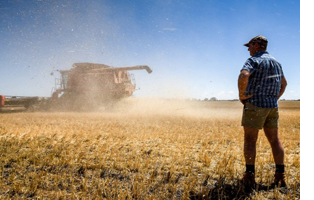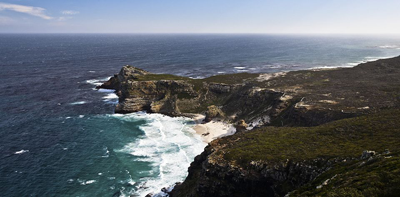DesalData Weekly - November 18, 2015
Posted 18 November, 2015 by Mandy

Early this week in Australia’s state of Victoria, Premier Daniel Andrews’ Labour government announced a $27 million package of measures to reallocate water resources and alleviate drought.
The main proposed project to improve Victoria’s water supply will be the creation of 40 kilometres of trunk pipelines and four new pumps, which will be installed at Woosang, Korong, Vale, and Wychitella.
Wheat farmer Leon Hogan on his property, where his harvest is down 80 percent from last year | Credit: Justin McManus
Local landowners will be able collect and carry the water from the pumps for domestic purposes. In the later stages of the project, the new pipelines will also enable landholders to connect to the Wimmera Mallee Pipeline.[1] Daniel Andrews has said he hopes the new pipes will complete any “remaining gaps” in Victoria’s water grid.[2] Compared to the $750 million budget for the creation of the 70 kilometre North-South Pipeline completed in 2010—current costs pale in comparison. Andrews further stated that the state’s currently unused $4 billion seawater desalination plant, located in Wonthaggi, was too far from drought-affected areas to provide any relief.
The state of Victoria, located on the continent’s southeastern coast, is defined by rugged coastline and vast expanses of forests. A lack of rainfall since July 2014 has parched extensive expanses of land in the north and west, and greatly diminished water storage levels. While Melbourne’s water supply is at more than 70 percent of capacity, storage levels in some areas of the north-west are at 30 percent due to poor rainfall.[3] Indeed, parts of western and south-eastern South Australia have received the lowest rainfall on record, and by next month, several rivers in Victoria will stop flowing altogether.
As part of the package, Water Minister Lisa Neville has explained to Melbourne’s water retailers that 75 gigalitres in Lake Eildon that had been promised to them will instead remain in northern Victoria to help drought-stricken areas (the Labour government provides an annual supply of water to Melbourne retailers because of their investment in the North-South Pipeline that carries water from the Goulburn River to Melbourne’s water distribution network at Sugarloaf Reservoir).[4] To compensate the water retailers, Neville has said that Melbourne’s emergency supply of water will be sourced from Victoria’s desalination plant, which costs $1.8 million a day for operations and maintenance.
The government’s new water plan will also continue the former government’s authorization for water retailers to sell water from Lake Eildon on the open market (when the catchments are flush).[5] Water Minister Neville has stated that the new arrangement will compel retailers to sell that allocation of water from the Lake, to the north.

Cape Point Nature Reserve, Western Cape Credit: Philip Milne
The Western Cape of South Africa, where Cape Winelands, lush mountains, and a vast coastline press upon the Atlantic, a vast water crisis has taken hold. The provincial government and its municipalities are considering water reclamation and seawater desalination as options to improve the region’s water supply.[6] One option includes the expansion of the Brandvlei Dam, which, when merged with the adjacent Kwaggaskloof Dam, becomes a large lake with a capacity of 458 million cubic metres.
Conflicting reports have emerged from the Western Cape Government regarding desalination. The Minister of Environmental Affairs, Anton Bredell, has said the province is planning to build desalination plants in Cape Town and along the West Coast. The Cape Chamber of Commerce President, Janine Myburgh, has likewise spoken in support of desalination and suggested it should become “normal practice” in the nation as it is in the Middle East. The national government’s water resource strategy states that by 2030, desalination plants could provide up to 10% of South Africa’s urban water supply.[7]
Meanwhile, the Minister for Economic Opportunities, Alan Winde, has said that desalination is not an option and that the region would instead “look to use water wisely.” The energy needs of the plant would presumably strain South Africa’s already-stressed electricity grid. Neil Armitage, head of the University of Cape Town’s Department of Civil Engineering, and Director of the Urban Water Management Research Unit—has said desalination should be a last resort: “If the energy comes from nuclear sources, there are safety concerns and problems with the disposal of waste.”[8]
[1] “Water Projects Fast-Tracked for Communities Facing Drought,” Premier of Victoria, The Hon. Daniel Andrews MP, November 16, 2015, http://www.theage.com.au/victoria/water-reforms-make-desalinated-water-more-likely-for-melbourne-20151116-gkzxpz.html>
[2] Ibid.
[3] Josh Gordon, “Desalination Plant Could be Switched on,” The Age – Victoria, October 7, 2015, <http://www.theage.com.au/victoria/desalination-plant-could-be-switched-on-20151006-gk2nlw.html> accessed October 7, 2015.
[4] Marc Moncrief and Josh Gordon, “Water Reforms Make Desalinated Water more likely for Melbourne,” The Age – Victoria, November 16, 2015, <http://www.theage.com.au/victoria/water-reforms-make-desalinated-water-more-likely-for-melbourne-20151116-gkzxpz.html> accessed November 17, 2015.
[5] Ibid.
[6] Bekezela Phakathi, “Western Cape weighs use of desalination plants,” Business Day Live, November 6, 2015
[7] Ibid.
[8] Ibid.
